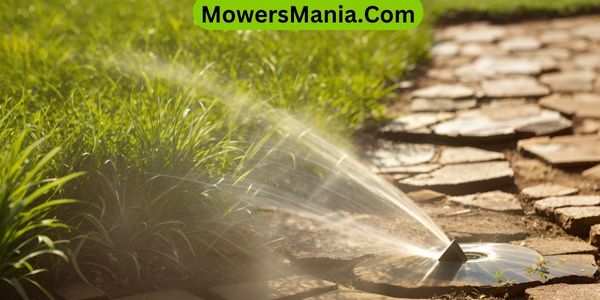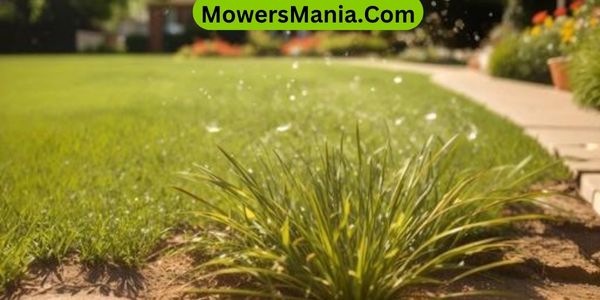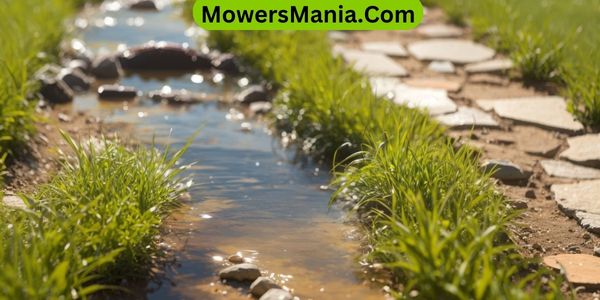Are you struggling to keep your lawn healthy and green during the scorching summer months? Look no further! In this article, we will provide you with essential tips and techniques to combat heat stress and drought.
From identifying signs of stress to choosing the right grass varieties, watering techniques, mowing practices, and fertilizing strategies, we’ve got you covered.

Get ready to transform your lawn into a vibrant oasis with our expert advice.
Understanding Heat Stress
To understand heat stress and its impact on your lawn during the summer, it’s important to recognize the signs and symptoms early on. Heat stress occurs when your lawn is exposed to excessively high temperatures and is unable to cope with the heat.
One of the first signs of heat stress is a change in color. Your lawn may turn yellow or brown, indicating that it’s struggling to survive in the extreme heat.
Another symptom to look out for is wilting. If the grass blades are drooping and appear lifeless, it’s a clear indication that your lawn is under stress.
Additionally, heat stress can cause the soil to become dry and compacted, making it difficult for the grass roots to access water and nutrients.
In severe cases, heat stress can lead to the death of your lawn if not treated promptly. Therefore, it’s crucial to take action as soon as you notice these signs.
Watering your lawn deeply and frequently, providing shade, and avoiding excessive foot traffic can all help alleviate heat stress and keep your lawn healthy during the summer months.
Identifying Signs of Drought
You should regularly inspect your lawn for signs of drought. Catching the early indications of drought stress can help you take appropriate measures to revive your lawn before it suffers irreversible damage.
Here are some key signs to look out for:
| Signs of Drought |
|---|
| Wilting or curling leaves |
| Discoloration or browning of grass |
| Footprints or mower tracks that remain visible |
| Slow or no grass growth |
Wilting or curling leaves are one of the first signs of drought stress. When water is scarce, grass blades will try to conserve moisture by curling or wilting.
Discoloration or browning of grass is another telltale sign. As the lawn lacks water, the grass will lose its vibrant green color and may turn yellow or brown.
If footprints or mower tracks remain visible after walking or mowing, it indicates that the grass is not springing back due to lack of moisture. Finally, if your lawn has slow or no grass growth, it could be a result of drought stress.
Choosing the Right Grass Varieties

One important consideration when dealing with heat stress and drought is selecting the appropriate grass varieties. Choosing the right grass can make a significant difference in the health and appearance of your lawn during the hot summer months.
Here are some factors to consider when making your selection:
- Heat tolerance: Look for grass varieties that are known for their heat tolerance. These types of grasses are better able to withstand the scorching temperatures and retain their vibrant green color.
- Drought resistance: Opt for grass varieties that have a high tolerance for drought conditions. These grasses can survive with minimal water, reducing the need for constant irrigation during dry spells.
- Root depth: Grasses with deep root systems are better equipped to access water deep within the soil. These varieties are more resilient to drought and can maintain their lush appearance even in challenging conditions.
- Maintenance requirements: Consider the level of maintenance required for each grass variety. Some types may need more frequent mowing, fertilization, or watering, while others are more low-maintenance.
Watering Techniques for Summer Lawns
When it comes to maintaining your lawn during the summer months, it’s essential to employ effective watering techniques that will help your grass withstand heat stress and drought.
Proper watering is crucial for the health and vitality of your lawn, especially when the temperatures soar and rainfall becomes scarce.
To start, it’s important to water your lawn deeply and infrequently. This means giving your lawn a good soaking, allowing the water to penetrate the soil to a depth of at least 6 inches.
This encourages the roots to grow deeper, making your grass more resilient to drought conditions. Watering deeply also helps prevent shallow root growth, which can make your lawn more susceptible to heat stress.
Timing is also key when it comes to watering your lawn. It’s best to water early in the morning, between 6 am and 10 am.
This allows the water to be absorbed by the grass before the heat of the day sets in, reducing the risk of evaporation. Watering in the evening or at night can lead to prolonged moisture on the grass, which can promote the growth of diseases and fungi.
In addition to proper watering, it’s important to monitor the moisture levels of your lawn. One way to do this is by using a rain gauge or a moisture meter, which can help you determine when your lawn needs watering. Remember, the goal is to keep your lawn consistently moist, not overly saturated.
Implementing Proper Mowing Practices
When it comes to maintaining your lawn during the summer, implementing proper mowing practices is essential.
You need to pay attention to the frequency and height of your mowing, as cutting the grass too short can stress it out in hot weather.
It’s also important to use sharp blades for clean cuts and dispose of grass clippings properly to avoid smothering the lawn.
Mowing Frequency and Height
To effectively implement proper mowing practices during the summer, you should adjust the frequency and height of your lawn mower.
Here are some tips to help you maintain a healthy and attractive lawn:
- Mow frequently: During the summer months, grass tends to grow faster, so it’s important to mow more often. Aim to mow every 5-7 days to prevent the grass from becoming too long and stressed.
- Set the right height: Adjust your mower’s cutting height to around 3-4 inches. This allows the grass to develop a deeper root system, making it more resistant to drought and heat stress.
- Follow the ‘one-third’ rule: Never remove more than one-third of the grass height in a single mowing session. This helps to avoid shock and damage to the grass blades.
- Keep your mower blade sharp: A sharp blade ensures a clean cut, preventing the grass from tearing and becoming susceptible to disease.
Importance of Sharp Blades
To maintain a healthy and attractive lawn during the summer, it is crucial that you keep your mower blades sharp. Sharp blades not only make your mowing job easier, but they also contribute to the overall health of your grass.
Dull blades tear the grass rather than cutting it cleanly, causing stress and damage to the plant. When the grass is torn, it becomes more susceptible to diseases, pests, and drought.
Additionally, torn grass blades have a higher water loss rate, leading to increased heat stress during hot summer days. To ensure your blades are sharp, regularly inspect and sharpen them or replace them if necessary.
By implementing proper mowing practices and using sharp blades, you can help your lawn thrive even in the challenging summer conditions.
| Pros of Sharp Blades | Cons of Dull Blades |
|---|---|
| Clean and precise cuts | Torn and ragged cuts |
| Promotes healthy growth | Causes stress and damage to grass |
| Reduces water loss | Increases susceptibility to diseases and pests |
Proper Grass Clippings Disposal
To properly dispose of grass clippings and implement proper mowing practices, consider using them as mulch in your garden beds. This allows you to recycle the clippings and provide your plants with much-needed nutrients.
Here are four reasons why using grass clippings as mulch is beneficial:
- Retains moisture: Grass clippings act as a barrier, reducing evaporation and helping to retain moisture in the soil.
- Suppresses weeds: By covering the soil with a layer of grass clippings, you can prevent weed growth and minimize the need for herbicides.
- Adds nutrients: Grass clippings contain nitrogen and other essential nutrients that can enrich the soil and promote healthy plant growth.
- Improves soil structure: As the grass clippings break down, they contribute organic matter to the soil, improving its structure and fertility.
Fertilizing Strategies for Heat-Stressed Lawns
When it comes to fertilizing your heat-stressed lawn, there are a few key points to keep in mind.
First, consider adjusting your watering frequency and timing to ensure that the fertilizer is properly absorbed by the grass.
Second, choose a fertilizer that’s specifically formulated for heat-stressed lawns to provide the necessary nutrients.
Lastly, if you prefer an organic approach, explore the option of using organic alternatives that can help nourish your lawn without introducing harmful chemicals.
Watering Frequency and Timing
During the summer months, it’s crucial for you to consistently water and fertilize your heat-stressed lawn to maintain its health and vitality.
Here are some important tips to help you with watering frequency and timing for your lawn:
- Water deeply: Give your lawn a good soak to encourage deep root growth and make it more resilient to heat stress.
- Water in the early morning or late evening: Watering during these cooler times of the day reduces water evaporation and allows the grass to absorb the moisture more effectively.
- Avoid frequent shallow watering: Frequent light watering can promote shallow root growth and make your lawn more susceptible to drought.
- Adjust watering based on weather conditions: Increase watering during periods of extreme heat or drought, and decrease watering during cooler or rainy periods.
Choosing the Right Fertilizer
You should also regularly fertilize your heat-stressed lawn to ensure its health and vitality throughout the summer.
Choosing the right fertilizer is crucial for providing the necessary nutrients your lawn needs to thrive in hot and dry conditions.
Look for a fertilizer specifically designed for heat-stressed lawns, as it will contain the essential nutrients that help your grass withstand the stress of high temperatures.
Nitrogen is an important component to look for in a fertilizer, as it promotes healthy growth and helps repair any damage caused by heat stress.
Additionally, consider using a slow-release fertilizer, as it provides a steady supply of nutrients over time, avoiding the risk of over-fertilization.
Remember to follow the instructions on the fertilizer package for application rates and timing to achieve the best results for your lawn.
Implementing Organic Alternatives
To continue nourishing your heat-stressed lawn, incorporate organic alternatives into your fertilizing strategies. Here are some options to consider:
- Compost: Apply a layer of compost to your lawn to improve soil structure and provide essential nutrients.
- Organic fertilizers: Look for natural fertilizers that are high in nitrogen, phosphorus, and potassium to promote healthy growth.
- Mulching: Leave grass clippings on your lawn after mowing to provide organic matter and retain moisture.
- Aerating: Use a lawn aerator to create small holes in the soil, allowing nutrients and water to reach the grass roots more effectively.
Additional Tips for Summer Lawn Care

Regularly watering and mowing your lawn is essential for maintaining its health and appearance during the summer months. However, there are additional tips that can help you keep your lawn in top shape despite the challenges of heat stress and drought.
To further assist you, here are some additional tips for summer lawn care:
- Adjust your mowing height: Raise the blade height of your lawnmower to around 3 inches. This will promote deeper root growth, making your lawn more tolerant to heat and drought.
- Water deeply and infrequently: Instead of watering your lawn lightly every day, water deeply once or twice a week. This encourages the roots to grow deeper, providing better access to water during dry periods.
- Use a rain gauge: Install a rain gauge in your yard to accurately measure rainfall. This will help you determine if your lawn is receiving enough water naturally or if additional irrigation is needed.
| Tip | Description | Benefit |
|---|---|---|
| Adjust mowing height | Raise the blade height to 3 inches | Encourages deep root growth |
| Water deeply and infrequently | Water deeply once or twice a week instead of lightly every day | Promotes deeper root growth |
| Use a rain gauge | Install a rain gauge to measure rainfall accurately | Helps determine irrigation needs |
Frequently Asked Questions [FAQs]
What Are the Best Practices for Preventing Heat Stress in a Lawn During the Summer?
To prevent heat stress in your lawn during the summer, follow these best practices: water deeply and infrequently, mow at a higher height, provide shade where possible, and avoid applying fertilizer during hot periods.
How Often Should I Water My Lawn During a Heatwave?
During a heatwave, you should water your lawn at least once a week. However, if there are signs of heat stress, increase watering frequency to two or three times a week to ensure proper hydration.
Can I Use a Specific Type of Fertilizer to Help My Lawn Withstand Heat Stress?
Yes, you can use a specific type of fertilizer to help your lawn withstand heat stress. Look for one that is high in nitrogen, as this will promote healthy growth and help your lawn better cope with the heat.
Are Certain Grass Varieties More Resistant to Drought Than Others?
Certain grass varieties are more resistant to drought than others. You should consider planting these varieties in your lawn to help it withstand dry conditions.
Should I Adjust My Mowing Height During the Summer to Help My Lawn Cope With Heat Stress?
Should you adjust your mowing height during the summer? Yes, it can help your lawn cope with heat stress. Cutting the grass too short can expose the roots to the scorching sun, so keep it a little longer.
Conclusion
So in conclusion, by understanding the signs of heat stress and drought, choosing the right grass varieties, implementing proper watering and mowing techniques, and using fertilizing strategies, you can effectively maintain your lawn during the summer months.
Don’t forget to also follow additional tips for summer lawn care to ensure your lawn stays healthy and vibrant throughout the season.
Keep up with these practices and enjoy a beautiful, stress-free lawn all summer long.



